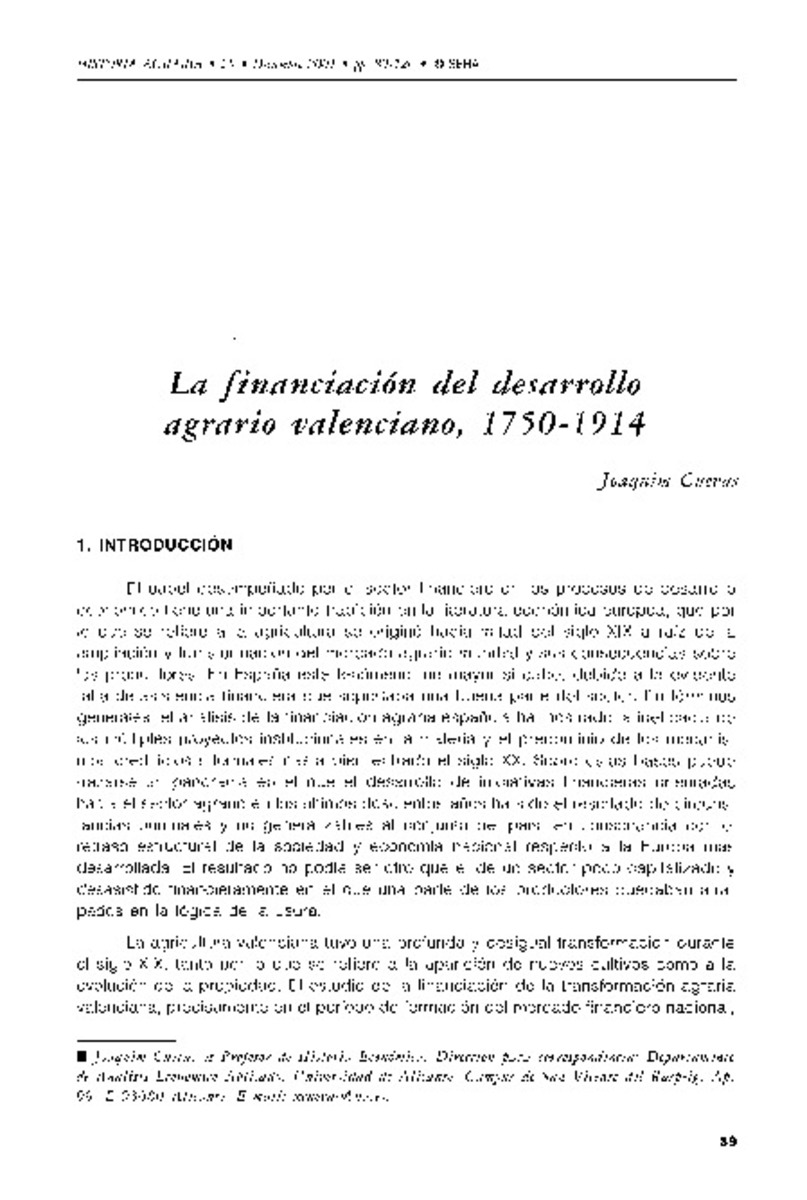Mostrar el registro sencillo del ítem
La financiación del desarrollo agrario valenciano, 1750-1914
| dc.contributor.author | Cuevas, Joaquim | |
| dc.date.accessioned | 2015-09-07T12:08:15Z | |
| dc.date.available | 2015-09-07T12:08:15Z | |
| dc.date.issued | 2001-12 | |
| dc.identifier.issn | 1139-1472 | |
| dc.identifier.uri | http://hdl.handle.net/10234/131546 | |
| dc.description.abstract | Este artículo analiza las principales vías de financiación del sector agrario valenciano entre finales del Antiguo Régimen y el inicio del siglo XX. Primeramente se estudian las instituciones de crédito, generalmente vinculadas a organismos y entes locales, tales como bancos agricolas, montepíos, pósitos y cajas de ahorros, concluyendo que su incidencia en la financiación de la transformación agraria valencíana no fue relevante, al menos hasta el desarrollo del cooperativismo desde 1890. En la segunda parte, por el contrario, se anaiizan dos ejemplos locales de financiación a través del crédito privado, no institucionalizado, representado por las retroventas, los censos, y principalmente las obligaciones. Por medio de fuentes notariales se demuestra el valor de los mecanismos crediticios informales, de naturaleza personalista y fuertemente discrecional, ya que la falta de especialización del tejido financiero valenciano y español del siglo XIX propició el desarrollo de mercados locales de liquidez cuyos rasgos esenciales estaban determinados por la demanda. | ca_CA |
| dc.description.abstract | This paper seeks to analyze the main ways of financing agrarian activities in the Valencian region from the end of the Ancien Régime and up until First World War. First, the formal financial institutions, generally linked to local entities, such as agricultural banks, mutual societies, cooperatives, and savings banks, are studied. A further aim of the paper is to show that trio role of such institutions in financing the agrarian transformation was not significant. at least until the emergence of the Cooperativist movement from 1890 onwards. On the contrary, in the second part, two local examples of financing are analyzed by means of non-institutionalised private credit, reflected in the reselling agreement, the censuses, and mainly private loans. From the minutes and archives of the Notaries Public, the role of the informal credit mechanisms and informal market is shown. The informal market was strongly based on personal relations and trust. Knowledge was at the heart of the system as the lack of specialization of the Spanish and Valencian financial system during the 19th Century facilitated the development of local liquidity markets whose essential features were determined by the demand. | ca_CA |
| dc.format.extent | 32 p. | ca_CA |
| dc.format.mimetype | application/pdf | ca_CA |
| dc.language.iso | spa | ca_CA |
| dc.publisher | Sociedad Española de Historia Agraria (SEHA) | ca_CA |
| dc.relation.isPartOf | Historia agraria: Revista de agricultura e historia rural, nº 25, p. 89-120 | ca_CA |
| dc.rights | © SEHA | ca_CA |
| dc.rights.uri | http://rightsstatements.org/vocab/InC/1.0/ | * |
| dc.subject | instituciones financieras | ca_CA |
| dc.subject | crédito informal | ca_CA |
| dc.subject | desarrollo agrario | ca_CA |
| dc.subject | confianza | ca_CA |
| dc.subject | mercados locales de liquidez | ca_CA |
| dc.subject | finantial institutions | ca_CA |
| dc.subject | informal credit | ca_CA |
| dc.subject | agrarian development | ca_CA |
| dc.subject | trust | ca_CA |
| dc.subject | local liquidity markets | ca_CA |
| dc.title | La financiación del desarrollo agrario valenciano, 1750-1914 | ca_CA |
| dc.type | info:eu-repo/semantics/article | ca_CA |
| dc.rights.accessRights | info:eu-repo/semantics/openAccess | ca_CA |
| dc.relation.publisherVersion | http://historiaagraria.com/info_articulo.php?id=286 | ca_CA |







